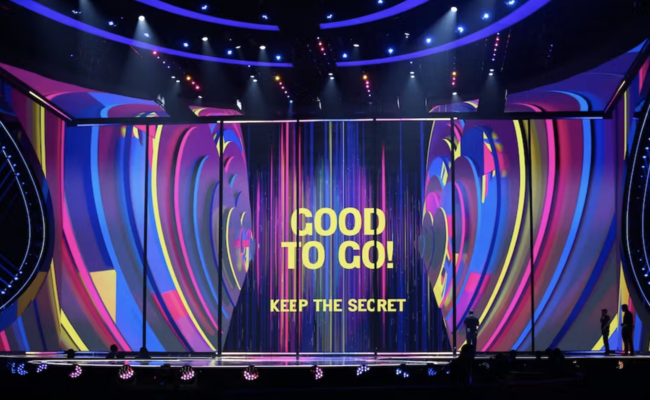(The stage of the 67th annual Eurovision Song Contest at the M&S Bank Arena in Liverpool. Adam Vaughan/EPA Images)
This week, Liverpool stages one of the world’s largest live televised events, the Eurovision Song Contest. I grew up watching it as an annual family get-together.
Now, as a lecturer in theatre and scenography – the study and practice of how set, sound, light and costume work together in an event – I have come to appreciate the immense logistical effort this entertainment behemoth requires.
More fascinatingly though, it is an extraordinary example of media and performance history, providing a yearly snapshot of pan-European national identities and politics.
While the contest’s rules state that it is a non-political event, it undeniably puts international relations on display. But while looking at different countries’ acts and voting patterns offers interesting insights, there is a silent star of the event that often goes unnoticed – the stage.
Staging a nation
Since the contest’s inception in 1956, there has been no serious discussion about the way Eurovision is an exercise in staging nation, nationality and nationalism in the literal sense – namely how these ideas inform the scenography.
2023 marks the first time Eurovision will be hosted in the runner-up’s country due to war, with the UK hosting on behalf of Ukraine.
The host’s stage set-up must be everything and nothing at the same time. It needs to provide a flexible, adaptable canvas for the wide-ranging individual acts of up to 44 countries. At the same time, it must offer a memorable and distinct experience to measure up to previous iterations of the competition.
The stage also needs to embody that year’s chosen theme, while meeting the extensive requirements of the European Broadcasting Union (EBU), which organises the event, in order to allow the competition to run efficiently.
2023’s theme is “united by music”. After the UK’s difficult departure from the EU, it now faces the challenge of staging itself as part of a united European community. Meanwhile, it also needs to give space to Ukraine to do the same.
The Liverpool stage’s designer, Julio Himede, has repeatedly offered the image of a hug – of open arms welcoming Ukraine and the world – as central to the stage’s spatial configuration.
The early days of Eurovision were a much smaller affair than nowadays. When the UK first hosted in 1960 at the Royal Festival Hall in London, it seated just 2,500 people. That’s less than a quarter of this year’s 11,000 at the Liverpool arena.
And if you have been watching the semi-finals, you’ll already have a good sense of the sheer scale of this year’s stage. At 450m², it is almost as big as a basketball court. With an integrated lighting design through video-capable floor and ceiling tiling and huge LED screens, the only apt descriptor is “spectacular”.
For Eurovision, the concepts, symbols and metaphors underpinning the design have to work in tandem with the creative vision of each delegation, as well as the 45 second turnover between acts in the live show.
The design concept also has to be one that acknowledges the particular situation of this year’s contest and simultaneously unites the identities of Ukraine and the UK.
Ultimately, the image of the hug that underpins the sweeping curve of the main stage space aims to offer a more universal theme, rather than one which is culturally specific. Viewers will notice the “open arms” of the stage are echoed in the arrangement of the “green room”, where the national delegations are located during the show.
In this sense, Eurovision is a prime example of a “soft power” approach to international relations, which works by persuasion or influence, rather than the “hard power” of economic sanctions or military intervention.
The UK after Brexit
This year, it will be fascinating to see how much space the UK will give to Ukraine, not only last year’s winner but a nation in need of international recognition and support. And to what extent the UK will use this event, post-Brexit, to stage itself as a welcoming part of Europe.
The UK does have a history of highly successful agit-prop events, which have engaged audiences emotionally to shape public opinion. Think back to the 2012 London Olympics opening ceremony, which strove to inspire a sense of national identity.
In 2023, the UK sees itself in the middle of global instability and national tension over mounting authoritarianism and widening social divisions. Once again, it has the chance to use an international stage to put forward an idealised narrative.
In any such example, the stage underpins the entire event. It is essential to the atmosphere for the live audience and fundamental to its appearance on television.
There is no doubt that Eurovision 2023 is a staging extravaganza and will test the UK’s capability to shake off its “sick man of Europe” image. It is a stage which offers the UK the opportunity to adjust its global image in line with the contest’s welcoming theme.
It will be interesting to see whether the image of open arms for the world is sincere or cynical.
Lara Maleen Kipp, Lecturer in Theatre and Scenography, Aberystwyth University
This article is republished from The Conversation under a Creative Commons license. Read the original article.
